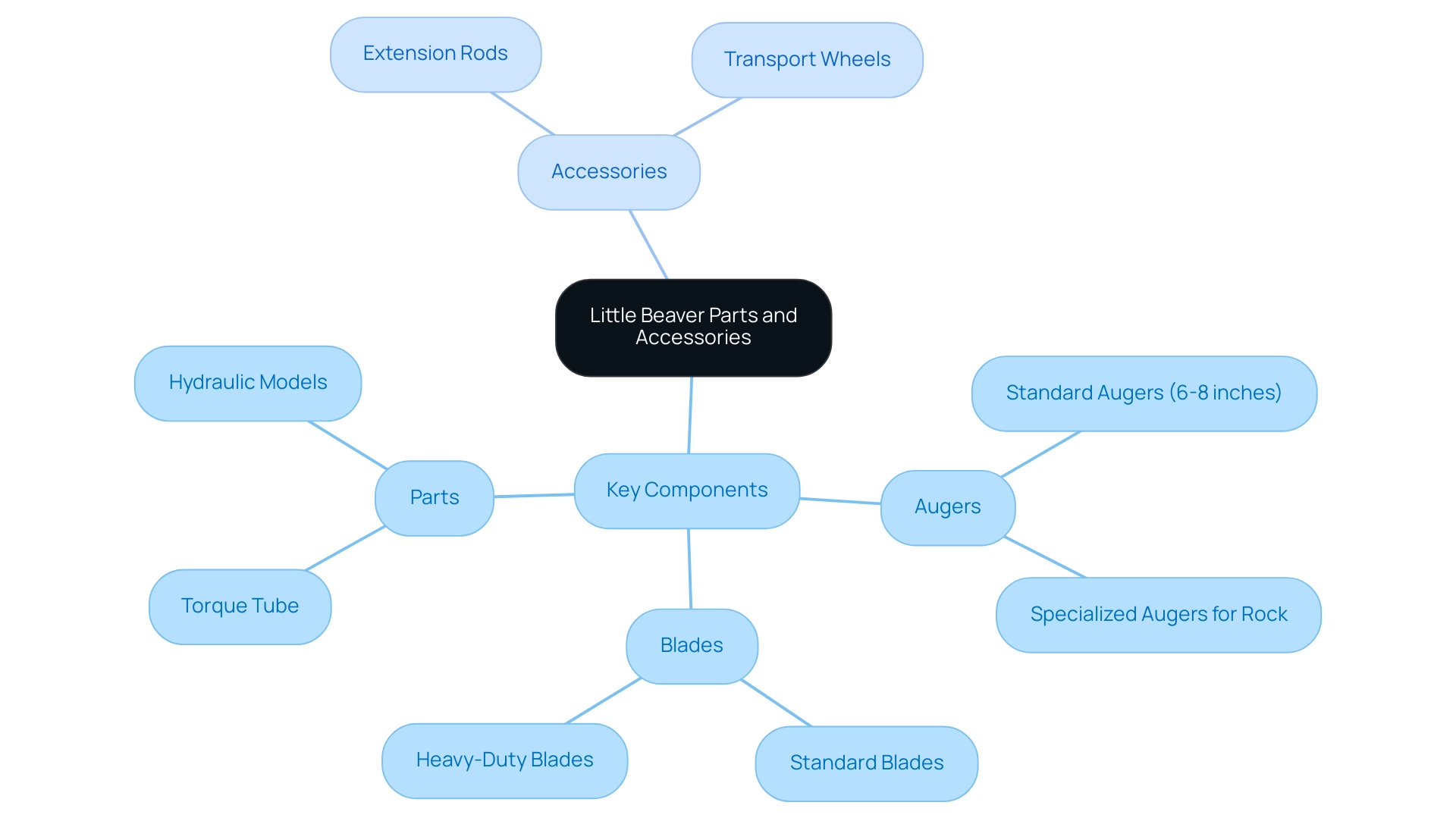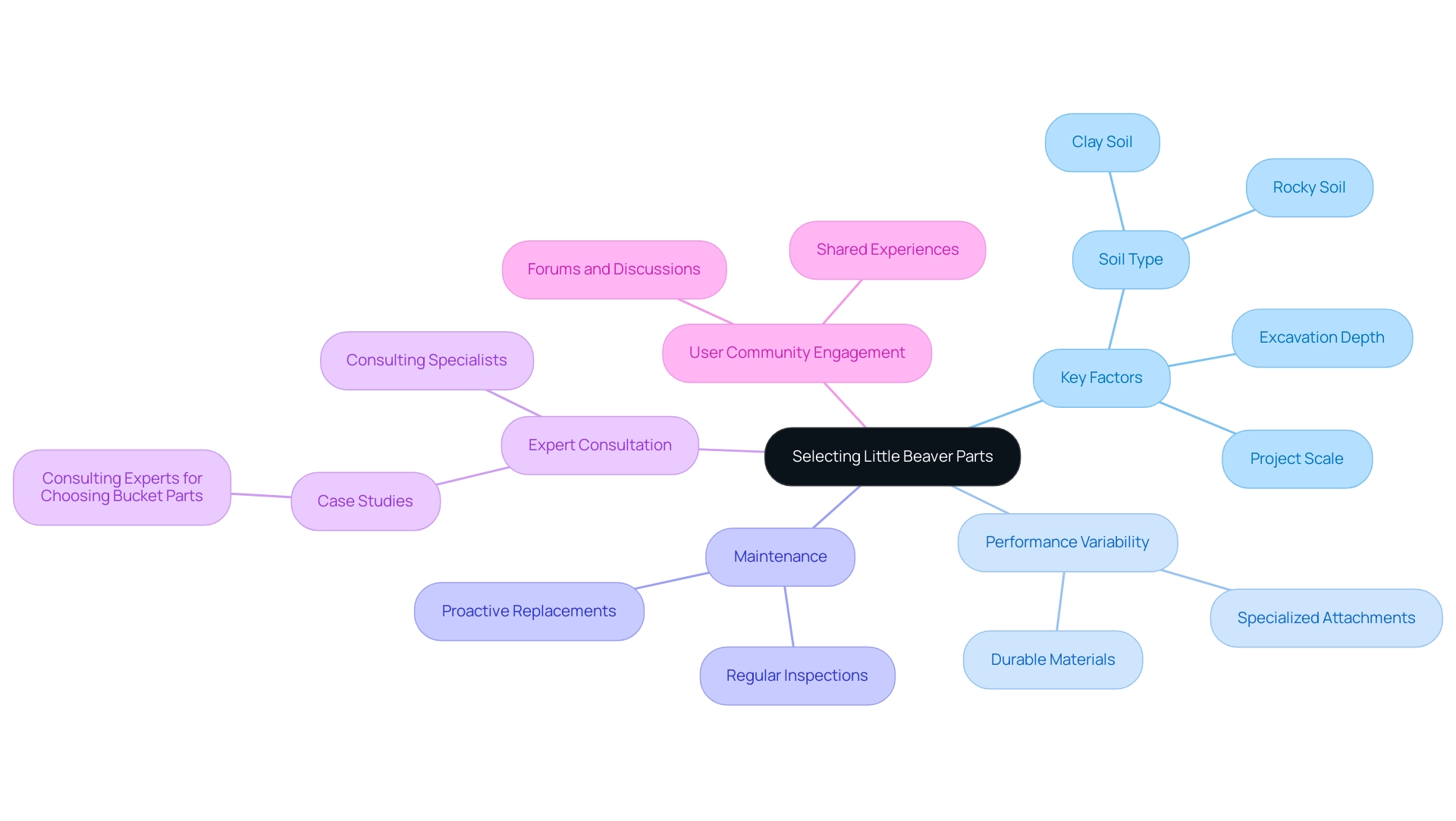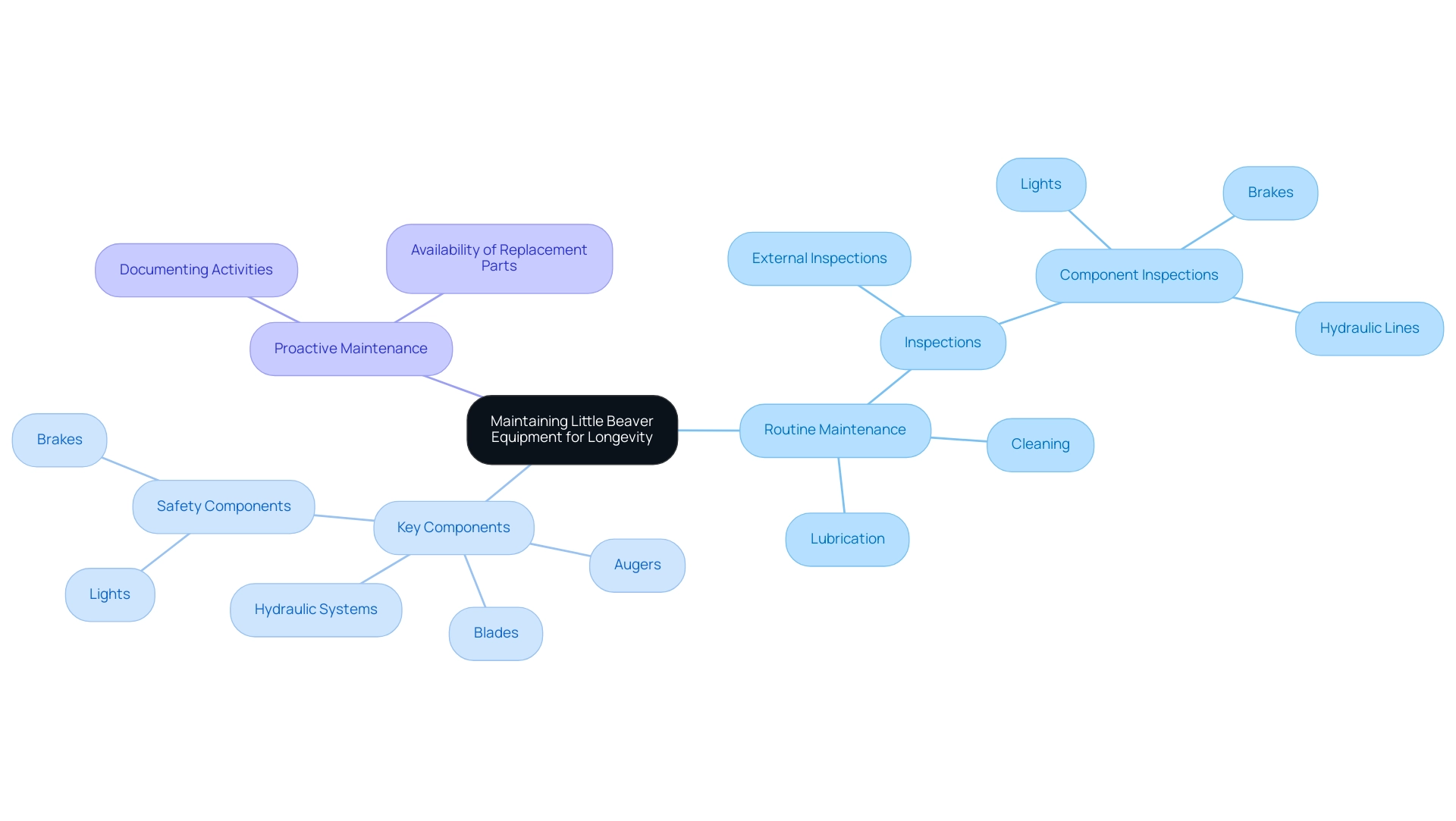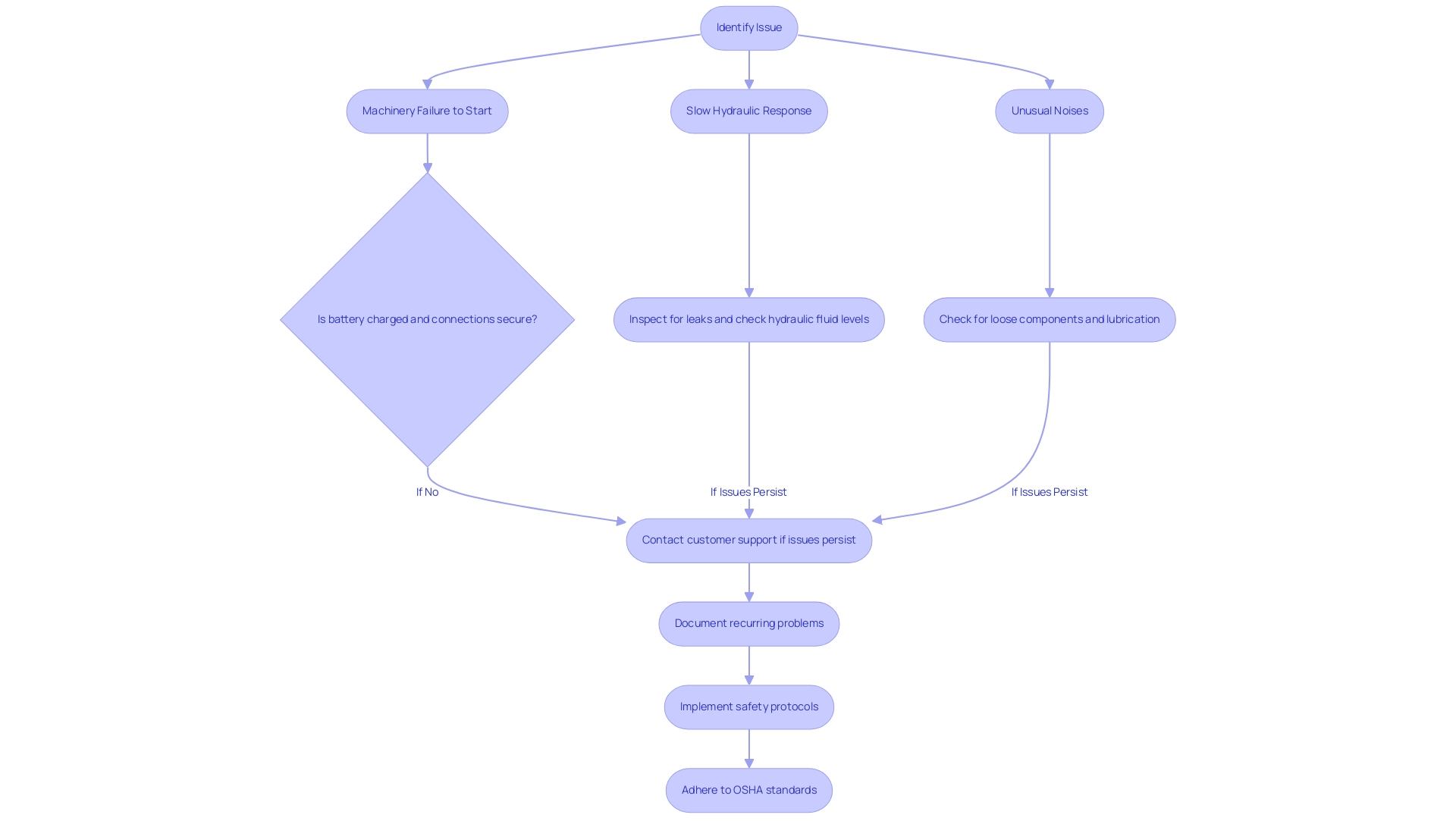Overview
Choosing and using Little Beaver parts effectively involves understanding specific project requirements and maintaining the equipment properly to enhance performance and longevity. The article emphasizes that selecting the right components based on soil conditions and implementing a routine maintenance schedule can significantly improve operational efficiency and prevent costly downtime, thereby ensuring successful project execution.
Introduction
In the competitive landscape of construction and excavation, the right tools and components can make all the difference between success and setbacks. Little Beaver has established itself as a key player, offering a comprehensive range of parts and accessories designed to enhance the performance and durability of their equipment. Understanding how to effectively select, maintain, and troubleshoot these components is essential for maximizing efficiency on the job site.
From specialized augers tailored for various soil conditions to expert tips on routine maintenance and problem-solving techniques, this guide aims to equip professionals with the knowledge needed to navigate the complexities of Little Beaver equipment. By leveraging these insights, operators can ensure their projects run smoothly, ultimately leading to improved productivity and reduced downtime.
Understanding Little Beaver Parts and Accessories
The small rodent provides a comprehensive array of components and accessories, including little beaver parts, that are precisely crafted to enhance both the performance and durability of their devices. Since 1979, when Joe and John Haynes took over the company, they have incorporated modern technological advancements, developing revolutionary components like the torque tube and expanding the product line to include hydraulic models. Familiarity with these components is essential for enhancing maintenance practices and overall performance on the job site.
Key components comprise different kinds of augers, blades, and parts from little beaver, each designed for specific functions and requirements. For instance, augers are available in different sizes and types, specifically designed to tackle a range of soil conditions and drilling depths, typically between 6 to 8 inches for horizontal boring. As highlighted in a case study on , understanding how to adjust drilling strategies when encountering rocks is crucial for success.
Accessories such as extension rods and transport wheels can significantly boost operational efficiency. To ensure optimal performance, always refer to the catalog or website of the small animal to identify little beaver parts that are compatible with your specific model. This diligence in selecting the right components will lead to well-informed purchasing decisions, ultimately contributing to the success of your endeavors.
As highlighted by a certain individual, with the right equipment, horizontal boring can be easy, emphasizing the significance of proper tools and upkeep.

Expert Tips for Selecting and Using Little Beaver Parts
When choosing little beaver parts from Little Beaver, it’s essential to customize your selections to the specific requirements of your task. Begin by evaluating key factors such as soil type, excavation depth, and the overall scale of the project. For instance, when working with clay soil, choosing an auger specifically made for difficult conditions can significantly improve efficiency and reduce wear on tools.
According to industry statistics, the performance of excavation machinery can vary dramatically based on soil types, with clay and rocky soils often requiring specialized attachments to maintain optimal efficiency. Additionally, as YNF Machinery states, 'By choosing durable materials, you extend the lifespan of and minimize the need for frequent replacements.' Staying informed about the latest product updates is essential, as the small animal consistently refines their components for enhanced performance.
Proper installation and ongoing maintenance are fundamental; always consult the user manual for comprehensive instructions. Regular inspections for wear and tear should be a routine practice—proactive replacements can prevent unexpected machinery downtime. Furthermore, citing case studies, like consulting specialists for selecting little beaver parts, demonstrates the importance of expert perspectives in making informed choices about the machinery.
Engaging with user communities or forums can also be priceless, providing shared experiences and troubleshooting guidance that may offer new perspectives on enhancing your tools. By integrating these best practices, you can ensure that your projects run smoothly and efficiently.

Maintaining Little Beaver Equipment for Longevity
To ensure the little beaver parts of your tools function at peak performance, it’s crucial to implement a comprehensive routine maintenance schedule. This should feature regular inspections of key components such as:
- Augers
- Blades
- Hydraulic systems
For instance, starting external inspections can help identify potential issues before they escalate, as highlighted in the case study 'Start Your Inspection From the Ground,' which emphasizes the importance of conducting thorough inspections from outside the vehicle.
Regular inspections of various components, such as:
- Lights
- Brakes
- Hydraulic lines
help maintain safety and functionality. Cleaning the tools after each use is essential to prevent the accumulation of dirt and debris, which can lead to mechanical failures and increased downtime. Lubricating moving parts according to the manufacturer's guidelines is equally important for smooth operation.
Furthermore, having little beaver parts readily available for quick replacements—especially for high-wear components—can significantly reduce operational interruptions. Documenting all maintenance activities is vital; this practice not only helps track performance over time but also aids in identifying recurring issues that may require further attention. As the saying goes, 'The choice is yours: stay ahead or fall behind.'
This quote highlights the importance of proactive maintenance, which is essential to preventing costly failures and ensuring your projects run smoothly. Additionally, with earning an average salary of $71,330 per year, investing in routine maintenance is not only a best practice but also a financially sound decision.

Common Troubleshooting Techniques for Little Beaver Parts
When facing operational issues with little beaver parts, the first step is to consult the user manual for model-specific troubleshooting guidance. Common challenges include:
- Machinery failure to start
- Slow hydraulic response
- Unusual noises
For starting issues, begin by verifying the power source: ensure the battery is charged and that all connections are secure.
If slow hydraulic performance is noted, inspect for leaks and check that hydraulic fluid levels are sufficient. Unusual noises may indicate loose components or a lack of lubrication; identifying the source is crucial for resolution. It's important to document any recurring problems, as over 60% of accidents in construction occur within an employee’s first year, underscoring the necessity for practical safety training.
Additionally, 73% of contractors report recordable injury rates due to safety programs, highlighting the critical nature of implementing effective safety protocols. Regular health monitoring and planning to reduce exposure to vibrating tools can help avert conditions such as , which can be alleviated by providing suitable protective gear and training. If problems continue, think about contacting the customer support team for expert help, ensuring your devices operate efficiently and safely.
Furthermore, adhering to OSHA standards, such as those related to fall protection and hazard communication, is essential for maintaining a safe work environment.

Leveraging Little Beaver Parts for Project Efficiency
To enhance efficiency in your construction endeavors in Dallas, it is crucial to strategically integrate little beaver parts into your workflow, alongside essential equipment like boom lifts. These lifts play a vital role in tasks such as roofing repairs and exterior painting, significantly improving worker safety and operational efficiency. Begin by assessing the specific requirements of each phase to select components that will optimize performance effectively.
For instance, using an auger designed for quick drilling can drastically reduce excavation time, thereby speeding up timelines. Training your team on best practices for utilizing these parts and boom lifts is equally important; research indicates that effective training can significantly enhance usage outcomes. Moreover, encouraging a cooperative atmosphere among team members facilitates the exchange of tips and experiences, resulting in innovative uses of the tools that further improve overall project efficiency.
It's worth mentioning that:
- 32% of owners and contractors currently depend on , indicating a potential area for improvement in adopting specialized machinery like little beaver parts and boom lifts to enhance productivity.
- 56% of construction firms lack a dedicated R&D budget, highlighting the pressing need for investment in specialized equipment to drive innovation and efficiency.
- The staggering $1.6 trillion wasted due to productivity lags underscores the consequences of insufficient context in management.
By implementing these strategies, you can not only improve project efficiency and safety but also mitigate the risks associated with the construction industry’s common issues, such as material wastage, which can reach up to 15% on construction sites. For in Dallas, consider EZ Equipment Rental as your go-to solution provider.
Conclusion
Understanding and effectively utilizing Little Beaver parts and accessories is vital for achieving optimal performance in construction and excavation projects. By selecting the right components tailored to specific project demands, such as soil type and excavation depth, operators can significantly enhance efficiency and minimize wear on equipment. Regular maintenance practices, including thorough inspections and timely replacements, ensure that equipment remains in peak condition, preventing costly downtime.
In addition to proper selection and maintenance, having a proactive approach to troubleshooting common issues is essential. Familiarity with the equipment and its components, along with leveraging expert resources and user communities, can empower operators to resolve problems swiftly and effectively. This knowledge not only boosts productivity but also contributes to a safer work environment.
Ultimately, integrating Little Beaver parts strategically into project workflows not only accelerates timelines but also enhances overall operational efficiency. By fostering a culture of collaboration and continuous learning among team members, construction professionals can drive innovation and adapt to the evolving demands of the industry. Embracing these strategies will lead to smoother project execution, reduced material wastage, and improved outcomes, ensuring success in the competitive landscape of construction and excavation.
Frequently Asked Questions
What types of components and accessories does the small rodent provide?
The small rodent offers a comprehensive array of components and accessories, including little beaver parts, designed to enhance the performance and durability of their devices. Key components include various augers, blades, and parts tailored for specific functions and requirements.
How have the products evolved since the company was taken over by Joe and John Haynes?
Since Joe and John Haynes took over in 1979, the company has incorporated modern technological advancements, developing revolutionary components like the torque tube and expanding their product line to include hydraulic models.
Why is familiarity with the components important?
Familiarity with the components is essential for enhancing maintenance practices and improving overall performance on the job site.
What should be considered when selecting little beaver parts?
When selecting little beaver parts, it’s important to customize choices based on specific task requirements, including soil type, excavation depth, and the overall scale of the project.
How do soil conditions affect excavation machinery performance?
The performance of excavation machinery can vary significantly based on soil types, with clay and rocky soils often requiring specialized attachments to maintain optimal efficiency.
What are some best practices for maintaining excavation equipment?
Best practices for maintaining excavation equipment include proper installation, ongoing maintenance, consulting the user manual for instructions, conducting regular inspections for wear and tear, and proactively replacing parts to prevent unexpected downtime.
How can engaging with user communities help with equipment maintenance?
Engaging with user communities or forums can provide shared experiences and troubleshooting guidance, offering new perspectives on enhancing tools and improving project efficiency.
Where can I find compatible little beaver parts for my model?
To find compatible little beaver parts, refer to the catalog or website of the small animal, ensuring that the components selected are suitable for your specific model.




